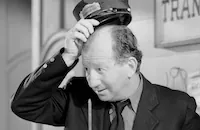Spite Marriage

Brief Synopsis
Cast & Crew
Edward Sedgwick
Buster Keaton
Dorothy Sebastian
Edward Earle
Leila Hyams
William Bechtel
Film Details
Technical Specs

Synopsis
Elmer, a pants-presser, falls in love with Trilby Drew, the star of a legitimate show, and attends every performance. Trilby is then jilted by her leading man, Lionel Denmore, and marries Elmer out of spite. She becomes intoxicated on their wedding night, and Elmer, realizing the reason for the marriage, leaves her and finds work as a sailor on a rumrunner's boat. Elmer later transfers at sea to a yacht on which Trilby is a passenger and proves his love and courage during a series of disasters. Trilby at last comes to realize her love for Elmer.

Director

Edward Sedgwick
Cast

Buster Keaton

Dorothy Sebastian
Edward Earle

Leila Hyams
William Bechtel
John Byron

Hank Mann
Crew

Videos
Movie Clip



Promo
Film Details
Technical Specs

Articles
Spite Marriage
Spite Marriage was an unqualified success at the time of its release, even though Keaton wasn't particularly thrilled to participate in its creation. He originally approached MGM production head Irving Thalberg with the idea of shooting a comic Western co-starring himself and Marie Dressler. But the creative autonomy Keaton received while writing, filming, and acting in such pre-MGM masterpieces as Steamboat Bill Jr. (1928) and The General (1927) was now a thing of the past.
Thalberg was constantly aware of the bottom line. He felt that Keaton's prior films, which were partly created out of time-consuming improvisations, were not as profitable as they could have been. Buster's first feature with MGM, The Cameraman (1928), was rather carefully supervised and did considerable business at the box office. Thalberg was convinced that Keaton - strictly adhering to a completed script - would benefit the studio.
It's ironic that Keaton - whose career would collapse partially due to the onset of talkies - wanted Spite Marriage to be his first sound picture. Though his brilliance as a physical performer was undeniable, he realized the success of Warner Bros.' The Jazz Singer (1927) marked the beginning of the end of the silent era. While interested in the possibilities of sound, Keaton, much like his comic peer, Charles Chaplin, was concerned that the new technology would be embraced to the eventual detriment of his art. He envisioned a type of comedy that would rely mostly on humorous sound effects. "It needn't be one long yak-yak," he told Thalberg.
Nevertheless, Thalberg insisted that Spite Marriage would be completely silent...especially since MGM had only one set of sound equipment at its disposal. Keaton and his director, Edward Sedgwick, forged ahead while chafing under the supervision of both Thalberg and producer Larry Weingarten, who happened to be married to Thalberg's sister. Luckily, this friction threw off some memorable sparks; many of the better moments in Spite Marriage arose via head-butting with the executives. "I'm afraid," Keaton said years later, "that Larry Weingarten was plenty sore, especially when the putting-the-bride-to-bed (sic) was such a success."
The sequence Keaton refers to is a genuine classic, in which he drunkenly attempts to get an equally inebriated Sebastian into bed without waking her up. It's a tour de force of comic timing, as he hauls his co-star around in a variety of ungainly positions. (Gregory Peck can be seen enacting the same routine, to less inspired effect, with Audrey Hepburn in Roman Holiday, 1953. Keaton also returned to it in the 1950s, frequently performing it on stage with his third wife, Eleanor Norris.) Though her work in this scene is severely inhibited by definition, Sebastian was the strongest actress to ever share the screen with Keaton. Their ease with one another can be traced to the fact that they were enjoying what would become a lengthy love affair while filming Spite Marriage.
Keaton and Sedgwick would go on to make seven more films together, all of which were talkies and far less rewarding than Spite Marriage. It's an often under-appreciated treasure, and the last fully realized display of Keaton's towering gifts as a filmmaker.
Director: Edward Sedgwick and Buster Keaton (uncredited)
Screenplay: Robert E. Hopkins and Lew Lipton
Art Direction: Cedric Gibbons
Cinematography: Reggie Lanning
Editing: Frank Sullivan
Costume Design: David Cox
Principal Cast: Buster Keaton (Elmer), Dorothy Sebastian (Trilby Drew), Edward Earle (Lionel Benmore), Leila Hyams (Ethyl Norcrosse), William Bechtel (Nussbaum), John Byron (Scarzi).
BW-76m.
by Paul Tatara

Spite Marriage
Quotes
Trivia
Buster Keaton wanted to this film to be a full talkie, but MGM released it with only a musical score and sound effects.














